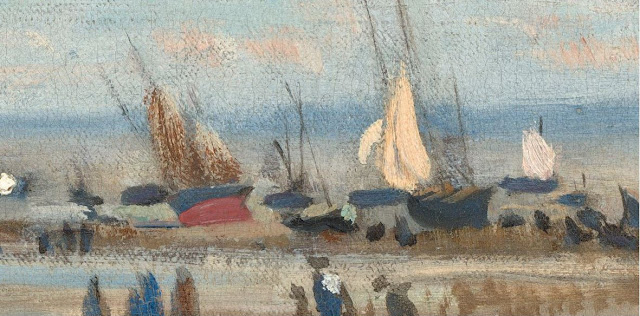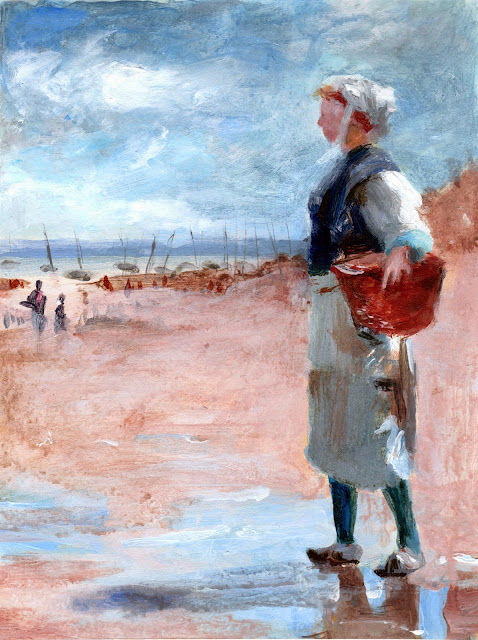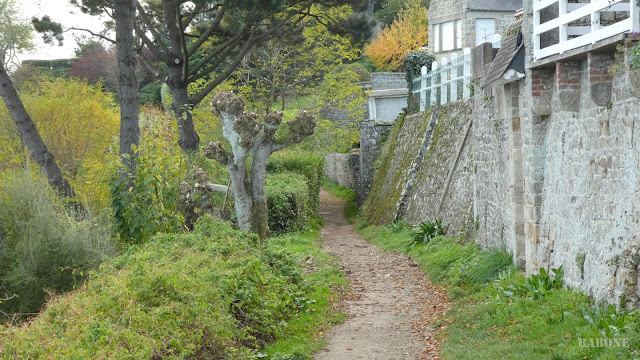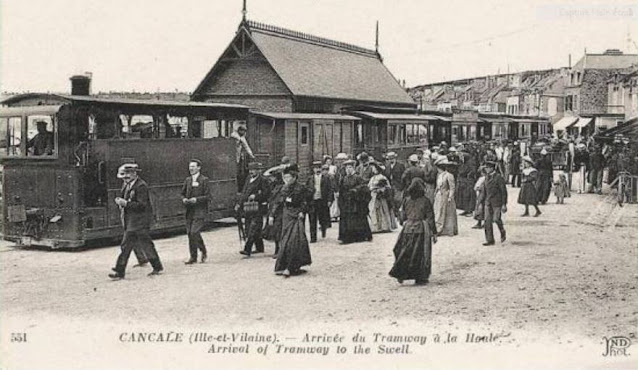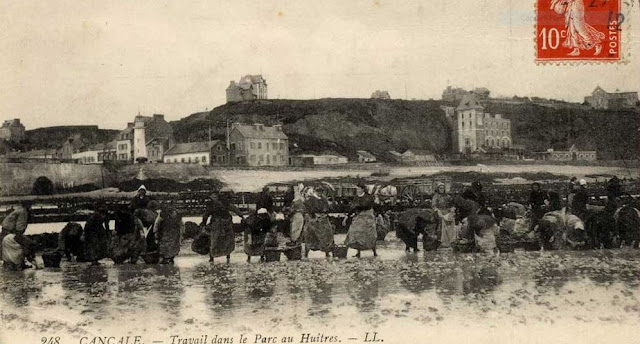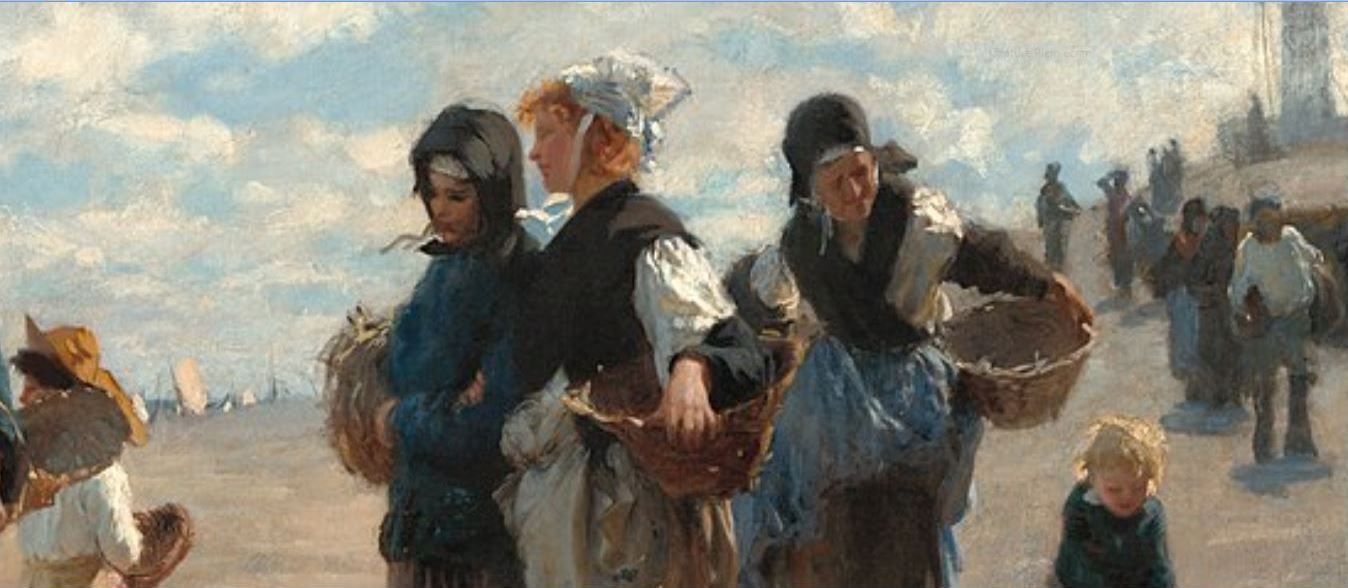 |
| les Cancalaises de Sargent, avec leurs coiffes, et leurs paniers d'osier |
John Singer Sargent, né le 12 janvier 1856 à Florence, et mort le 14 avril 1925 à Londres, est un peintre américain… mais il vécut essentiellement en Europe. l’Europe ce peut être l’Italie et l’Espagne, mais c’est forcément Paris… et pas si loin : Cancale !
 |
| dans son studio de Paris, un portrait typique de Madame Pierre Gautreau, dont la robe glisse un peu à droite : chocking ! |
L'atelier de Carolus-Duran dispense à la fois une approche académique traditionnelle qui exige une grande rigueur dans le dessin et la couche de fond, mais aussi un travail alla prima, au pinceau, directement sur la toile, comme le faisait Vélasquez. C'est une approche qui s'appuie sur un choix judicieux des tons de la peinture. Elle permet également un épanouissement spontané de la couleur, sans être liée au dessin de la sous-couche. Cet enseignement est sensiblement différent de celui de l'atelier traditionnel de Jean-Léon Gérôme, où les Américains Thomas Eakins et Julian Alden Weir étudient à cette époque.
Sargent devient rapidement un
élève vedette. Weir rencontre Sargent en 1874 et écrit que c'est « l'un de ses
camarades les plus talentueux… ; ses dessins sont comme ceux des maîtres
anciens, et sa couleur est de la même veine ». Sa maîtrise de la langue
française et son grand talent font que Sargent est à la fois populaire et
admiré. Grâce à son amitié avec Paul Helleu, Sargent rencontre de grandes
personnalités du monde artistique de l'époque, comme Edgar Degas, Auguste
Rodin, Claude Monet et Whistler.
 |
| je ne trouve pas de tableaux des Pyrénées, mais des aquarelles ou huiles du Tyrol et du Simplon |
À son retour, Sargent reçoit
rapidement plusieurs commandes de portraits. Sa carrière est lancée. Il se
montre immédiatement concentré et endurant, ce qui lui permettra de peindre
avec acharnement pendant les vingt-cinq années suivantes. Il comble les vides
entre ses différentes commandes en réalisant de nombreux portraits d'amis et de
collègues. Ses manières raffinées, son français parfait et son talent font de
lui une vedette parmi les nouveaux portraitistes et sa renommée s'étend
rapidement. Il annonce avec confiance des prix élevés et se permet même de
refuser certains clients pénibles : comme je le comprends !
 |
| Fishing for oysters at Cancale, 157 x 112cm 1878 |
Il a à peine 22 ans ! Je devine que depuis Paris, il vient à Saint-Malo en train ? (2) De là le tramway à vapeur l'emmène directement au port de Cancale et sa jetée. On reconnait la baie, la mer au loin, à droite en haut à cause de la dénivelée à marée basse, le phare toujours à la même place
on reconnait bien les bisquines affalées sur le côté à marée basse, et voici le phare
cette toile est à Londres à la National Gallery, comme ce serait bien de la rapatrier ici,
(en dédommagement de l'interdiction de pêcher dans les eaux anglaises
post Brexit) !
J'en ai trouvé une seconde, puis la jeune Bretonne au panier, peut-être y en a-t-il d'autres ?
 |
| j'ai toujours le même panier à maquereaux |
en ce moment, la navigation est réduite
je décide d'emprunter le chemin des douaniers
PS (1) : http://babone5go2.blogspot.com/2021/08/la-thangue-cancale.html
PS (2) : j'ai un problème : nous sommes donc en 1878, et le tramway St-Malo-Cancale ne sera fonctionnel qu'en 1893, quinze ans plus tard ! Comment John Sargent est-il donc vraiment venu à Cancale ?
est-il descendu à l'Hôtel de l'Europe ?
 |
| on a récemment re-découvert la voie métrique enterrée |

c'est noir de monde au départ !
When Sargent visited there in 1877, many of the men were away -- as they would often be through the nineteenth century -- sailing far into the ocean bound for the rich fisheries of Newfoundland, gambling big on a catch that might pay handsomely. Fathers, sons, brothers, sometimes many of the eligible men in a household might be gone for as long as six months from spring till fall.
In their absence, and left to their own resources, the women and children could not live on promises of a Newfoundland catch alone. What they did have, however, were conditions along a coastline that were so unusual, that as far back as the Romans, the area had been harvested for oysters.
Displayed with more than a little notice at the 1878 Paris Salon (see Road to Madame X), "Oyster Gatherers of Cancale" by a young, relatively unknown twenty-two year old American, was from the very beginning more than just a pretty sentimental picture; more than the artful handling of a cumulus-clouded sky on a beach with nameless natives; and more than just the skillful play of light in the reflective pools at their feet by a clever young foreigner; to the French who had been there; to the ones that understood the Cancalaises, this painting cut directly to an understanding beyond his years and beyond an outsider's view, right to the very inner soul of a Cancalaiser's life.
In the summer of 1877, when the men were absent (say for a few -- see background right) the women would come down from the village, having passed the village's lighthouse at point Cale. We are seeing a number of generations -- a grandmother, some young mothers, and children on their way to the oyster beds, baskets in hand and children in tow. They wear the traditional dress of the white headscarf and wooden shoes. The center women, dressed in black, appears to be in a nuns habit similar to what was worn by Jeanne Jugan who founded "Les Petites Sœurs des Pauvres" (little sisters for the poor) in Saint-Malo.
 |
| Jeanne Jugan (Cancale 1792 Saint-Malo 1879), artiste inconnu |
Although impressionistic and with the method of Carlous-Duran that painted figures with little to no drawing and outlining, the spontaneity of figures and freshness of his brush belies the very calculated composition that Sargent presents. Back at his studio in Paris, he worked relentlessly on this pulling a whole host of sketches together -- starting -- stopping -- pacing back and forth with that manic energy -- frustrated -- a hand pulling on his beard -- a furrowed brow -- muttering under his breath -- pitching the entire thing and re-attacking again until he could do it from his gut -- quick -- fresh strokes -- sure and unquestioning -- until . . . .Until he had exactly what he wanted.
For Sargent, "Oyster Gatherers of Cancale" would forever be a seminal moment in the evolution in his art. What he would learn here, he would use over and over to teach students at the Royal Academy in later years. The matrix of complexity from composition, to handling of paint, to the power of light were all here! For Sargent, "Oyster Gatherers" defined his style. Nothing was left to chance. Nothing replaced hard work. Nothing excused anything short of a total understanding and empathy for his subject. And nothing -- NOTHING -- substitute practice -- and more practice until his brush was the completely-tuned extension of his mind.
Note : Special thanks to Madeleine Bruchet, who's parents lived in Cancale, and a friend of the JSS Gallery, and for her big help with this page on Cancale.






